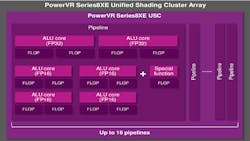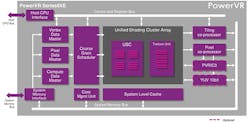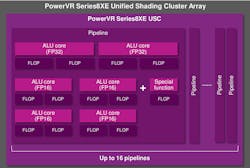GPU Targets Smartphones with Hardware Virtualization and Multi-Domain Security
Cost-conscious designs such as IoT wearables, low-end smartphones, set-top boxes, and automotive systems can benefit from Imagination Technologies’ latest PowerVR Series 8XE GPUs (Fig. 1). This latest PowerVR Rogue platform provides the same fillrate as the earlier Seriex 7XE, but using 25% less silicon real estate plus a corresponding reduction in power.
The GPUs do not target compute applications so they do support OpenCL, but they do come with drivers for OpenGL ES 3.2 and the new Vulkan 1.0 interface designed to provide game developers with closer ties to the hardware. Vulkan allows developers better access to the Unified Shading Cluster (USC) array includes 16 pipelines. Each pipeline includes a pair of 32-bit floating point ALU cores and four 16-bit floating-point ALU cores.
The markets that the PowerVR Series 8XE GPUs serve tend to be more interested in lower cost and smaller footprints, but Imagination has also delivered performance and advanced functionality. Its support for hardware virtualization and OmniShield multi-domain security allow the operating system to isolate applications and operating systems so more flexible platforms can be built that will support downloadable applications while not providing them with unrestricted access to the graphics hardware.
The PowerVR SDK v4.0 supports the PowerVR Series 8XE. In comes with a number of improvments including Android 6.x and Android TV support via PVRHub and the PVRShaderEditor now supports tessellation and geometry shaders. PVRTune handles optimization and also supports the earlier GPUs. The PVRTrace debugging tool includes Android Extension Pack (AEP) support. The PowerVR SDK v4.0 is distributed under an MIT license.
About the Author
William G. Wong
Senior Content Director - Electronic Design and Microwaves & RF
I am Editor of Electronic Design focusing on embedded, software, and systems. As Senior Content Director, I also manage Microwaves & RF and I work with a great team of editors to provide engineers, programmers, developers and technical managers with interesting and useful articles and videos on a regular basis. Check out our free newsletters to see the latest content.
You can send press releases for new products for possible coverage on the website. I am also interested in receiving contributed articles for publishing on our website. Use our template and send to me along with a signed release form.
Check out my blog, AltEmbedded on Electronic Design, as well as his latest articles on this site that are listed below.
You can visit my social media via these links:
- AltEmbedded on Electronic Design
- Bill Wong on Facebook
- @AltEmbedded on Twitter
- Bill Wong on LinkedIn
I earned a Bachelor of Electrical Engineering at the Georgia Institute of Technology and a Masters in Computer Science from Rutgers University. I still do a bit of programming using everything from C and C++ to Rust and Ada/SPARK. I do a bit of PHP programming for Drupal websites. I have posted a few Drupal modules.
I still get a hand on software and electronic hardware. Some of this can be found on our Kit Close-Up video series. You can also see me on many of our TechXchange Talk videos. I am interested in a range of projects from robotics to artificial intelligence.



